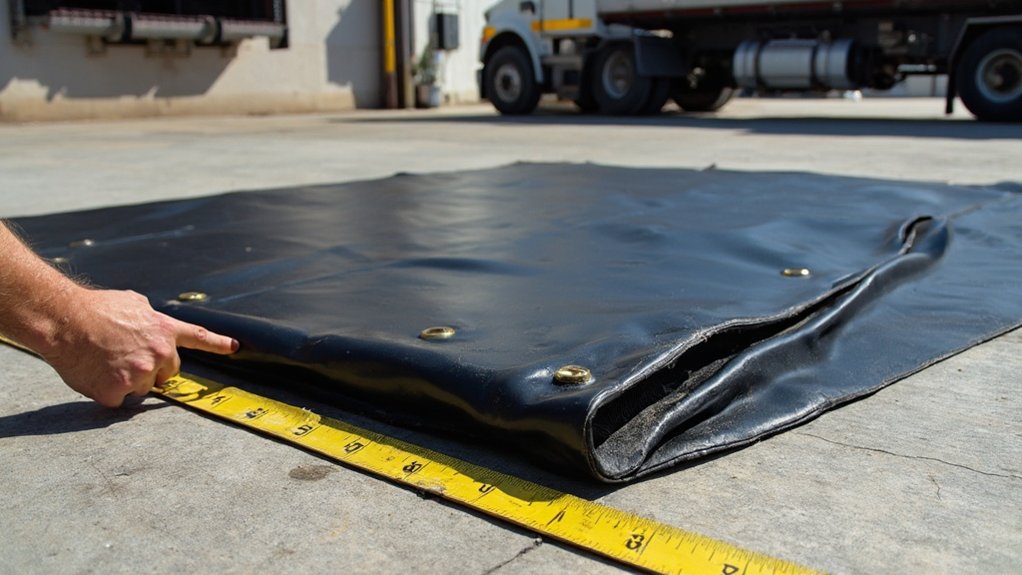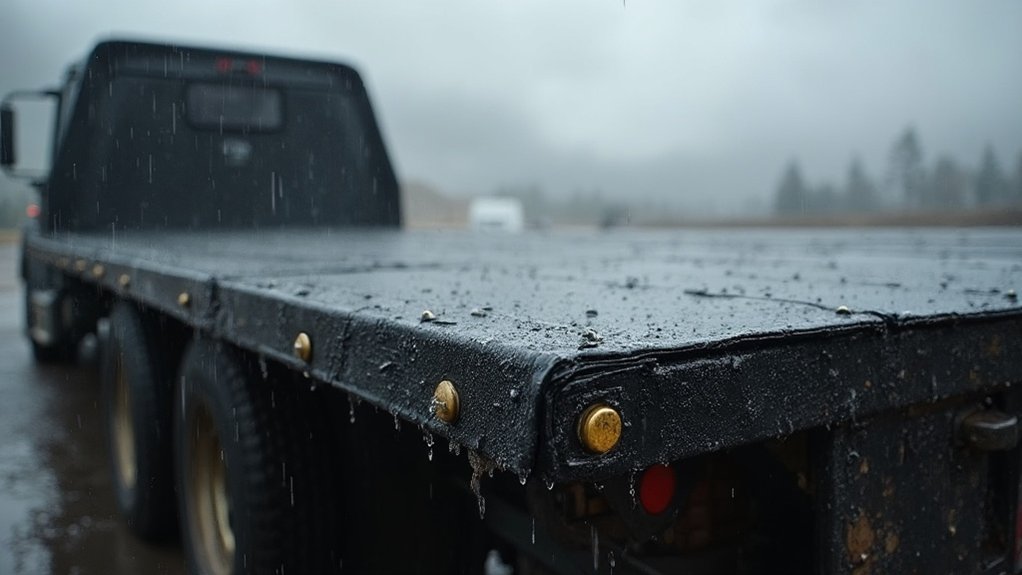When choosing a flatbed tarp, we’ll want to focus on material type, size, and specific hauling needs. Vinyl tarps offer excellent durability at 14-22 oz with superior waterproofing, while polyethylene provides a budget-friendly option for occasional use. For sizing, we measure load dimensions and add twice the desired drop length to trailer width. Quality mid-range vinyl-coated polyester tarps ($300-$500) typically deliver better long-term value than cheaper alternatives needing frequent replacement. Regular maintenance, including proper cleaning and storage, extends lifespan considerably. Understanding these key factors will reveal the full potential of your hauling investment.
Key Takeaways
- Select tarp material based on cargo type and climate, with vinyl offering best durability and polyethylene being cost-effective for occasional use.
- Measure load dimensions accurately and choose a tarp slightly larger to account for shrinkage and ensure complete coverage.
- Consider weather resistance ratings, including cold crack resistance and UV protection, based on your operating environment.
- Evaluate cost versus longevity, as premium tarps ($400-600) typically offer better value through extended lifespan and superior protection.
- Match tarp style to cargo needs: steel tarps for low-profile loads, lumber tarps for tall cargo, mesh for ventilation.
Understanding Tarp Material Types
Selecting the right tarp material is essential for protecting your flatbed cargo and maximizing the return on your investment. Let’s explore the four main types of tarps we commonly use in flatbed trucking, each offering distinct advantages for different hauling needs.
Vinyl tarps are our go-to choice for heavy-duty applications. With tarp weights ranging from 14 to 22 ounces and heat-sealed seam types, they’re built to withstand severe weather while providing excellent waterproofing and UV protection. Each tarp features heavy-duty nylon webbing around its perimeter for enhanced durability. Polyethylene tarps offer a cost-effective solution for shorter trips, delivering good protection while keeping our operating costs down.
When we’re hauling cargo that needs to breathe, canvas tarps are our best option. They’re durable and can include vinyl coating for extra protection. Some feature heat-sealed seam types that enhance their longevity. For specialized loads requiring exceptional protection, we turn to Kevlar tarps. While less common and typically more expensive, they provide unmatched strength for high-value or sensitive cargo that demands extra security. Consider using lumber tarps with flaps for tall, box-shaped loads that require complete coverage. By matching our tarp selection to specific hauling requirements, we guarantee ideal cargo protection while managing costs effectively.
Common Flatbed Tarp Categories
Let’s examine the key differences between steel and lumber tarps, with steel options being ideal for lower-profile loads and lumber tarps better suited for taller, boxed cargo. The 18 oz coated construction makes both tarp types highly durable for demanding transport conditions. These robust tarps incorporate industrial grade materials to withstand extreme wear and tear during transit. When considering mesh versus canvas materials, we’ll find mesh offers better ventilation but less protection, while canvas provides superior weather resistance at a higher cost point. Understanding these categorical differences helps us make cost-effective choices that match our specific hauling needs while maintaining load protection standards.
Steel Vs Lumber Options
Two primary categories dominate the flatbed tarp market: steel tarps and lumber tarps, each designed for specific load types and operational requirements. When we’re handling steel loads, we’ll benefit from steel tarps’ compact 4-foot drop design and enhanced durability features, including D-rings every 24 inches and reinforced stitching. Steel tarp benefits include superior abrasion resistance and specialized construction for dense, heavy materials like rods and sheets. The PVC-coated polyester construction of steel tarps provides exceptional durability for heavy-duty applications. These tarps maintain their structural integrity even at cold crack resistance ratings of -40°F.
In contrast, lumber tarp versatility makes them ideal for those of us hauling diverse cargo types. With their generous 8-foot drop and built-in end flaps, we can effectively protect longer, bulkier loads like lumber and hay bales. While both options utilize 18 oz PVC-coated materials, lumber tarps offer greater flexibility for various load profiles.
We’ll need to carefully consider our typical cargo when choosing between these options. For steel transport, we should prioritize durability and proper sizing with steel tarps. If we’re handling multiple cargo types, lumber tarps offer broader application. Remember, regulatory compliance and load security remain paramount regardless of our choice, so we must guarantee our selection meets all operational requirements.
Mesh and Canvas Types
Both mesh and canvas tarps serve critical roles in flatbed operations, each offering distinct advantages for specific cargo requirements. When considering mesh advantages, we’ll find superior breathability that prevents moisture buildup and lightweight handling characteristics that make our daily operations more efficient. These mesh options excel particularly in transporting aggregate materials like stone, gravel, and construction debris. The vinyl coated polyester construction ensures optimal durability while maintaining flexibility. Our stock includes 18 oz vinyl options that deliver exceptional strength for steel transport applications.
Canvas applications shine when we need enhanced protection combined with breathability. We’ll benefit from their robust construction and water-resistant properties, typically enhanced with silicone and flame-retardant treatments. Their reinforced seams and grommets, especially in 21 oz varieties with D-rings, guarantee reliable performance in demanding conditions.
For heavy-duty requirements, we can opt for premium mesh tarps that offer increased coverage through tighter weave patterns while maintaining essential ventilation. These serve us well in extreme weather conditions, providing the durability we need for challenging transport scenarios. When selecting between mesh and canvas options, we should prioritize our specific cargo requirements, considering factors like load type, distance, and weather exposure to make the most cost-effective choice.
Sizing Your Tarp Correctly

Accurate tarp sizing stands as the foundation for effective flatbed load protection. Let’s explore essential tarp sizing techniques to guarantee we’re making smart investments in our equipment. We’ll start by measuring our load’s length, width, and height – these dimensions serve as our baseline for selecting the right tarp size.
When we’re calculating the required width, we’ll add twice the desired drop length to our trailer’s width. For example, if we need a 4-foot drop on each side of an 8-foot trailer, we’ll need a 16-foot wide tarp. Remember, it’s better to have a slightly larger tarp than one that’s too small, as we need to account for potential shrinkage over time. Getting these measurements right is crucial since improper sizing can lead to load damage.
Standard sizes like 16’ x 27’, 20’ x 27’, and 24’ x 27’ are common in our industry, but we should always take accurate measurements before making our selection. We’ll want to take into account both the finished and cut sizes, as hemming can reduce the final dimensions. For custom loads, we might need to specify exact requirements to guarantee proper coverage, particularly when dealing with tall cargo or specialized equipment that requires specific drop lengths. Each tarp comes equipped with heavy-duty D-rings along the sides to ensure maximum load security during transport.
Durability and Material Strength
With our tarp properly sized, we’ll need to focus on selecting materials that can withstand the demanding conditions of flatbed transport. We’ve found that heavy-duty vinyl tarps, weighing 18-22 ounces per square yard, offer the best durability for professional hauling. These tarps combine superior load capacity with exceptional weather resistance, lasting 5-10 years with proper maintenance.
While polyethylene tarps might seem cost-effective initially, their 1-3 year lifespan makes them less practical for our regular hauling needs. We need to take into account that our tarps will face constant UV exposure, moisture, and temperature extremes. That’s why we recommend investing in vinyl tarps with UV-resistant coatings and waterproof properties.
For loads requiring ventilation, mesh tarps provide a balance of durability and airflow, though they’ll typically last 2-5 years. Canvas tarps offer another breathable option with a 3-5 year lifespan, but they’ll need waterproofing treatment for wet conditions. When calculating long-term costs, remember that higher upfront investment in quality vinyl tarps typically results in lower replacement frequency and better load protection.
Cost Versus Value Analysis

Smart tarp investment requires carefully weighing initial costs against long-term value. When we conduct a cost analysis, we’ll find that while low-end polyethylene tarps ($150-$300) offer initial savings, they often require more frequent replacement. Mid-range vinyl-coated polyester options ($300-$500) typically provide better value through extended durability.
Our value assessment should consider bulk purchasing opportunities, as buying multiple tarps can reduce per-unit costs considerably. For example, we can save over $40 per tarp when purchasing 12 units versus three. We’ll also want to factor in maintenance costs, weather resistance, and load protection capabilities when calculating total ownership costs.
Let’s focus on long-term economics: high-end tarps ($400-$600) with reinforced hems and multiple D-rings often prove more cost-effective over time. They’re constructed with 18 oz vinyl-coated polyester, offering superior durability and weather resistance. When we account for the reduced replacement frequency and better load protection, premium tarps frequently justify their higher upfront cost. Additionally, we should consider warranties, return policies, and the manufacturer’s reputation to guarantee we’re making a sound investment in our equipment.
Essential Maintenance Tips
Proper maintenance of flatbed tarps directly impacts their lifespan and performance. Let’s focus on the essential practices that’ll help us protect our investment and guarantee reliable service from our tarps.
When it comes to tarp cleaning, we’ll want to start by removing loose debris with a soft brush. Then, we can use a garden hose with low pressure and a mild soap solution to clean the surface. We’ll need to be gentle while scrubbing and make sure we rinse thoroughly to remove all soap residue.
For tarp storage, we must always make certain our tarps are completely dry before putting them away. Let’s store them in a clean, dry area away from direct sunlight, which can cause material degradation. Rolling up our tarps, rather than folding them, helps prevent permanent creases that could lead to wear points.
We should inspect our tarps regularly for damage and address any issues promptly. When we find small holes or tears, let’s patch them immediately using appropriate materials. For larger damages, it’s worth considering professional repair services to maintain the tarp’s integrity and extend its useful life.
Weather and Environmental Protection

When we’re selecting flatbed tarps for our operations, we’ll need to carefully consider how regional weather patterns influence our protection requirements. We’re looking at climate-specific challenges like UV exposure in sunny regions, heavy rainfall in wet climates, or snow and ice in colder areas that directly affect our choice of tarp material and construction features. Our investment in weather-appropriate tarps with proper material thickness, reinforced seams, and adequate UV protection will greatly reduce cargo damage and extend tarp life across varying environmental conditions.
Climate Impact on Selection
Facing harsh weather conditions, flatbed drivers must carefully select tarps that can withstand their operating environment’s specific challenges. We’ve found that seasonal adjustments and proper tarp insulation are critical factors in protecting both our loads and equipment investments.
In cold climates, we need to be especially vigilant about our tarp selection. Vinyl tarps typically outperform poly tarps in winter conditions, as they’re less prone to becoming brittle and cracking. When we’re operating in areas with frequent temperature fluctuations, we’ll want to avoid canvas options due to their tendency to absorb moisture.
Let’s consider practical steps to extend tarp life in challenging conditions. We can warm our tarps in the cab before use, making them more pliable and less likely to tear. It’s essential we regularly inspect D-rings and grommets for salt damage and use rubber-tipped gloves for better grip in icy conditions.
For specialized loads, we must match our tarp system to specific cargo requirements. Different materials and load shapes may demand varying tarp thicknesses or coverage types, ensuring we maintain proper protection while maximizing operational efficiency.
Protection Against Harsh Elements
Building on our understanding of climate impacts, let’s examine specific protective measures against harsh elements. When we’re investing in tarp waterproofing techniques, we need to focus on heat-sealed seams and material selection that matches our specific needs. For long-term protection, we’ll want to choose heavy-duty vinyl tarps (18-22 ounces) with industrial-grade construction.
UV protection strategies start with selecting materials containing UV inhibitors. We’ve found vinyl tarps excel in this area, offering superior protection against sun damage. While poly tarps provide good UV resistivity at a lower cost, they’re better suited for our short-term applications.
For peak protection, we’ll want to guarantee our tarps feature reinforced edges and sturdy grommets. These elements are essential when we’re securing loads in challenging weather conditions. If we’re hauling specialized cargo, we should consider purpose-built options like lumber tarps or steel tarps that offer 100% waterproofing and mildew resistance. When dealing with loads requiring ventilation, parachute tarps give us the perfect balance of protection and breathability, combining waterproof materials with breathable fabric sections.
Regional Weather Considerations
Through careful analysis of regional weather patterns, we’ll need to adapt our tarp selection and installation methods to match specific environmental challenges. When dealing with cold weather, we’ve found that heavy-duty vinyl tarps (18-22 ounces) offer the best protection. We recommend warming these tarps in the truck cab before use to prevent cracking and maintain flexibility during installation.
In areas prone to high winds, we must prioritize durability and proper fastening techniques. Let’s focus on tarps with heat-sealed seams and reinforced edges, as they’re proven to withstand intense conditions. We’ll want to avoid thin plastic materials that can shred and guarantee tight installation to prevent water-pooling voids.
Temperature variations require special consideration. We’re looking at tarps rated for -20°F to 160°F, with vinyl polyester being our go-to material for extreme conditions. UV protection becomes critical in high-temperature regions, so we’ll select tarps with built-in UV inhibitors. For wet conditions, we’ll rely on waterproof materials like vinyl and canvas, properly installed to prevent pooling and guarantee load security while meeting regulatory requirements.
Frequently Asked Questions
Can Flatbed Tarps Be Used With Non-Standard or Unusual Cargo Shapes?
We can effectively secure cargo containment for unconventional shapes using flatbed tarps, thanks to their adjustable straps, multiple tie-down points, and modular designs that adapt to virtually any load configuration.
How Often Should Flatbed Tarps Be Inspected for Damage During Long Trips?
We should inspect our tarps at every stop during long trips, checking tarp maintenance points like grommets, D-rings, and bindings. Our inspection frequency guarantees safety and prevents costly damage.
What’s the Average Lifespan of a Properly Maintained Flatbed Tarp?
We’ll typically see 5-10 years from vinyl tarps and 1-3 years from polyethylene when we maintain them properly. Let’s extend tarp material durability through regular cleaning, timely repairs, and proper storage.
Are There Specific Regulations for Tarp Colors in Different States?
We don’t face any specific tarp color regulations for state compliance. We can choose any color that works for our needs, as states focus on proper load securement instead.
Can Flatbed Tarps Be Effectively Cleaned Without Professional Services?
We can effectively clean our flatbed tarps using DIY tarp maintenance methods at home. Following proper tarp cleaning methods with mild soap, soft brushes, and thorough rinsing saves money and extends lifespan.
Conclusion
We’ve covered the essentials of flatbed tarp selection, from materials to sizing. As you make your decision, remember to prioritize durability and weather resistance over initial cost savings. By investing in quality tarps that match your specific hauling needs, you’ll reduce replacement frequency and protect cargo more effectively. Regular maintenance and proper sizing will maximize your investment and guarantee peak performance in all conditions.
